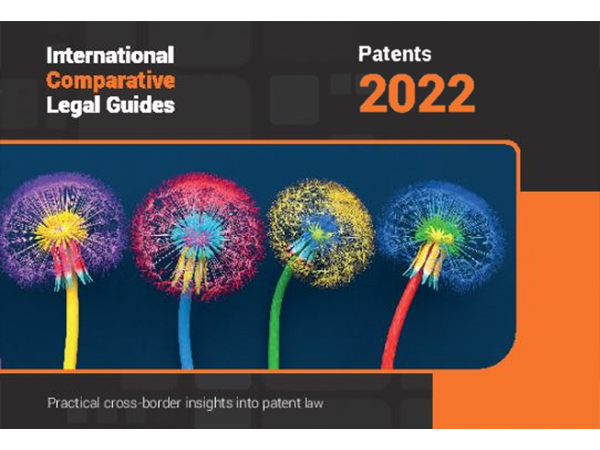
Intellectual Property
Viewpoints
Filter by:
EXCLUSIVE RIGHTS: Intellectual Property — Patent Damages Deep Dive with Mintz and BDO – Part II of II
July 29, 2021 | Podcast | By Andrew DeVoogd, Daniel Weinger
In Part II of this damages-focused series of the EXCLUSIVE RIGHTS: Intellectual Property podcast, Mintz IP attorneys Drew DeVoogd and Daniel Weinger join guest David Duski of BDO for a more detailed discussion of apportionment of damages in patent litigation.
Read more
EXCLUSIVE RIGHTS: Intellectual Property — A Patent Damages Deep Dive with Mintz and BDO — Part I of II
July 22, 2021 | Podcast | By Andrew DeVoogd, Daniel Weinger
In this episode of the EXCLUSIVE RIGHTS: Intellectual Property podcast, Mintz IP attorneys Drew DeVoogd and Daniel Weinger welcome guest David Duski for the first of a two-part series covering patent trial damages.
Read more
The USPTO’s Patent Classification and Search Systems Have Jumped on the AI Bandwagon
July 8, 2021 | Blog | By Christina Sperry, Amanda Metell
It is no question that Artificial Intelligence (“AI”) technologies have popped up in all aspects of society such as online shopping, music streaming, and social networking. The U.S. Patent and Trademark Office (“USPTO”) has even reported that patents which incorporate AI has increased from under 5% in 1980 to over 20% in 2018. Among those organizations that utilize AI is the USPTO itself.
Read more
EXCLUSIVE RIGHTS: Intellectual Property — Protecting Music (and Other Creative Works) with Copyrights
July 8, 2021 | Podcast | By Daniel Weinger, Andrew D. Skale
In this episode of the EXCLUSIVE RIGHTS: Intellectual Property podcast, Mintz Intellectual Property attorneys Andrew Skale and Daniel Weinger explore copyright protections for music and other creative works.
Read more
PATENT 101: Key Considerations and Activities for Establishing a Patent Program (Part 1 of 3)
July 7, 2021 | Blog | By Michael Van Loy, Kevin Amendt, Nicholas Eadie
Tasked with starting an innovation protection and patent development program at your company but do not know where to begin? This three part series describes the key components to a patent development program for any company, small or large.
Read more
Supreme Court Hammers Final Nail in the IP Bridge v. TCL Coffin
July 2, 2021 | Blog | By Michael Renaud, Daniel Weinger
On Monday, the Supreme Court denied TCL Communication’s certiorari petition, without comment, appealing the Federal Circuit’s ruling that the essentiality of a patent claim is a question for the jury rather than judges to resolve during claim construction. The denial of cert by the Supreme Court cements the Federal Circuit ruling which made proving infringement of standard essential patents easier by allowing reliance on the standard to show such infringement.
Read more
Patent Owner Tip #11 for Surviving an Instituted IPR: Use It or Lose It (in the POR)
July 1, 2021 | Blog | By William Meunier
When faced with an instituted IPR, the Patent Owner should include all arguments it wishes to preserve for appeal in its Patent Owner Response (“POR”), including arguments that the Patent Owner believes are unlikely to succeed before the Board but may be attractive to the Federal Circuit. Otherwise, the argument will be deemed waived and unavailable in any subsequent appeal.
Read more
EXCLUSIVE RIGHTS: Intellectual Property — Arthrex: PTAB Lives to Fight Another Day with (a Bit) More Oversight
June 24, 2021 | Podcast | By Andrew DeVoogd, Daniel Weinger
In this episode of the EXCLUSIVE RIGHTS: Intellectual Property podcast, attorneys Drew DeVoogd and Dan Weinger break down the recent Supreme Court decision in United States v. Arthrex, where the Court found that Administrative Patent Judges (APJs) are hired in violation of the Appointments Clause, and crafted a new structure for the PTAB. The Arthrex case has far reaching implications not just in patent law, but across the administrative bodies of the federal government.
Read more
Arthrex SCOTUS Ruling: The IPR Show Must Go On, Just with (a Bit) More Oversight
June 24, 2021 | Blog | By William Meunier , Brad M Scheller , Andrew DeVoogd
On Monday, in a highly-anticipated decision, a fractured Supreme Court issued its opinion in Arthrex v. Smith & Nephew, striking a portion of the America Invents Act (AIA) as unconstitutional—but providing an effectively toothless remedy.
Read more
Patent Owner Tip #10 for Surviving an Instituted IPR: Address Claim Construction and Public Availability
June 24, 2021 | Blog | By Daniel Weinger, Sean Casey
When confronted with instituted IPRs, Patent Owners should identify and exploit issues that the Petition glossed over and bring those to the attention of the Board. This will highlight for the Board important issues that the Petition failed to sufficiently address and can lead to victory for the Patent Owner.
Read more
Fast Track to Justice for Trade Secret Theft at the ITC: New Senate Bill Would Expand ITC Authority to Curtail Trade Secret Theft by Foreign Governments
June 23, 2021 | Blog | By Michael Renaud, Rich Gervase, Nicholas Armington
Amid the continuing threat to U.S. intellectual property rights posed by foreign actors, the International Trade Commission (ITC) is poised to become the latest federal agency to bolster protections for U.S. IP owners. The ITC’s broad power to exclude the importation into the U.S. of products that infringe American intellectual property now has the potential to be made even more robust through a new bill introduced by Senators John Cornyn (R-Tex.), Christopher Coons (D-Del.), and Todd Young (R-Ind.) on June 15, 2021, that would provide expedited relief for trade secret theft victims.
Read more
Second Circuit Provides Clarity on “Inherently Suspect” Standard, Overturns FTC’s Ruling on 1-800 Contacts Trademark Agreements
June 21, 2021 | Blog | By Joseph Miller , Evelyn French
On June 11, 2021, the U.S. Court of Appeals for the Second Circuit dismissed the Federal Trade Commission’s (FTC) administrative order against 1-800 Contacts, Inc. The Second Circuit found that the online retailer’s trademark settlements with competitor online contact lens sellers were not “inherently suspect” and, instead, should be evaluated under the traditional rule of reason analysis. The trademark settlements specified, among other things, that 1-800 Contacts’ competitors would not bid on the company’s name as a keyword in online search advertising. This ruling has significant implications for the “inherently suspect” standard—according to the Second Circuit, “courts do not have sufficient experience with this type of conduct to permit [the FTC’s] abbreviated analysis.”
Read more
EXCLUSIVE RIGHTS: Intellectual Property — Descriptive v. Distinctive: How to Brand Your Business and Products
June 17, 2021 | Podcast | By Karen K. Won
In this episode of the EXCLUSIVE RIGHTS: Intellectual Property podcast, patent attorney Lily Zhang talks with trademark attorney Karen Won about the age-old choice between adopting descriptive brands or distinctive brands for businesses and products.
Read more
Reduced Scope of March-in Rights Under Bayh Dole Rules Revisions
June 16, 2021 | Blog | By Marc Morley
The Bayh Dole Act was enacted to provide incentives to promote commercialization of federally funded inventions and was designed to capitalize on the significant government investments in small business, university research, and other non-profit institutions.
Read more
PTAB Continues Streak of IPR Denials
June 14, 2021 | Blog | By Brad M Scheller
US Patent Trial and Appeal Board (PTAB) institution denials for inter partes review (“IPR”) and other post-grant review petitions have steadily risen from 13 percent in 2012 to 44 percent in 2020. In 2020, the institution rate has fallen to 56%, down from 63% a year ago.
Read more
Patent Owner Tip #9 for Surviving an Instituted IPR: Issues Warranting Limited Additional Discovery
June 10, 2021 | Blog | By Brad M Scheller , Monique Winters Macek
In our previous post we started talking about discovery procedures in inter partes review (“IPR”) proceedings under 37 CFR § 42.51 and, in particular, the scope and timing of seeking limited additional discovery under Rule 42.51(b)(2). We reviewed timing considerations and emphasized the importance of anticipating the need for additional discovery and, to the extent necessary, moving the Board as early as possible following Institution.
Read more
Supreme Court to Consider When Inaccurate Information in a Copyright Registration Affects its Validity in Unicolors v. H&M
June 9, 2021 | Blog | By Michael Graif
After five years of litigation, the battle between Unicolors, a California-based fabric design company, and H&M is still going strong. Now the United States Supreme Court has agreed to decide whether an inaccuracy in Unicolors’ copyright registration invalidates its registration and thus a jury’s $1 million damages award in Unicolors’ favor.
Read more
PTAB Admits Mistake, Reverses, and Institutes
June 8, 2021 | Blog | By Brad M Scheller , James Thomson
In a rare turn of events the Patent Trial and Appeal Board recently granted a rehearing request in Maxlite, Inc. v. Jiaxing Super Lighting Elec. Appl. Co., Ltd., No. IPR2020-00208, Paper 14 (P.T.A.B. June 1, 2021), stating that “we abused our discretion in denying institution” based on an improper allocation of the parties’ burdens when a petitioner challenges an alleged priority date.
Read more
EXCLUSIVE RIGHTS: Intellectual Property — Claim Construction Perspectives — from a Litigator and a Prosecutor
June 4, 2021 | Podcast | By Andrew DeVoogd
A PhD-holding patent prosecutor and a seasoned ITC and district court litigator talk claim construction. Can they possibly find common ground?
Read more
Failing to Adequately Support a Means-Plus-Function Claim Term Renders a Claim Invalid
June 3, 2021 | Blog | By Pedro Suarez, Joshua Berk
Claim language is important. Particularly when dealing with software systems, claims may be held invalid as being indefinite when the claim language is characterized as “means-plus-function” under pre-AIA 35 U.S.C. §112 ¶ 6 (now AIA 35 U.S.C. §112(f)).
Read more
Explore Other Viewpoints:
- Data Centers & Digital Infrastructure
- AI: The Washington Report
- Antitrust
- Appellate
- Arbitration, Mediation & Alternate Dispute Resolution
- Artificial Intelligence
- Awards
- Bankruptcy & Restructuring
- California Land Use
- Cannabis
- Class Action
- Complex Commercial Litigation
- Construction
- Consumer Product Safety
- Corporate Governance (ESG)
- Cross-Border Asset Recovery
- DEI Legal Developments
- Debt Financing
- Direct Investing (M&A)
- Diversity
- EB-5 Financing
- Education & Nonprofits
- Employment
- EnforceMintz
- Environmental (ESG)
- Environmental Enforcement Defense
- Environmental Law
- Environmental, Social, and Corporate Governance (ESG)
- FDA Regulatory
- False Claims Act
- Federal Circuit Appeals
- Financial Institution Litigation
- Government Law
- Growth Equity
- Health Care
- Health Care Compliance, Fraud and Abuse, & Regulatory Counseling
- Health Care Enforcement & Investigations
- Health Care Transactions
- Health Information Privacy & Security
- IP Due Diligence
- IPRs & Other Post Grant Proceedings
- Immigration
- Impacts of a New US Administration
- Insolvency & Creditor Rights Litigation
- Institutional Investor Class Action Recovery
- Insurance & Financial Services
- Insurance Consulting & Risk Management
- Insurance and Reinsurance Problem-Solving & Dispute Resolution
- Intellectual Property
- Investment Funds
- Israel
- Licensing & Technology Transactions
- Life Sciences
- Litigation & Investigations
- M&A Litigation
- ML Strategies
- Medicare, Medicaid and Commercial Coverage & Reimbursement
- Mergers & Acquisitions
- Patent Litigation
- Patent Prosecution & Strategic Counseling
- Pharmacy Benefits and PBM Contracting
- Portfolio Companies
- Privacy & Cybersecurity
- Private Client
- Private Equity
- Pro Bono
- Probate & Fiduciary Litigation
- Products Liability & Complex Tort
- Projects & Infrastructure
- Public Finance
- Real Estate Litigation
- Real Estate Transactions
- Real Estate, Construction & Infrastructure
- Retail & Consumer Products
- Securities & Capital Markets
- Securities Litigation
- Social (ESG)
- Special Purpose Acquisition Company (SPACs)
- Sports & Entertainment
- State Attorneys General
- Strategic IP Monetization & Licensing
- Sustainable Energy & Infrastructure
- Tax
- Technology
- Technology, Communications & Media
- Technology, Communications & Media Litigation
- Trade Secrets
- Trademark & Copyright
- Trademark Litigation
- Unified Patent Court (UPC)
- Value-Based Care
- Venture Capital & Emerging Companies
- White Collar Defense & Government Investigations
- Women's Health and Technology









